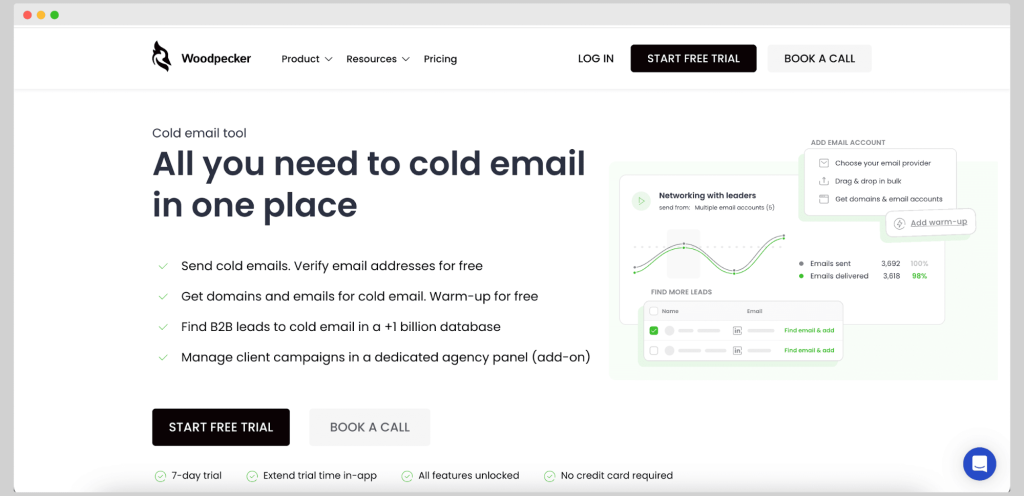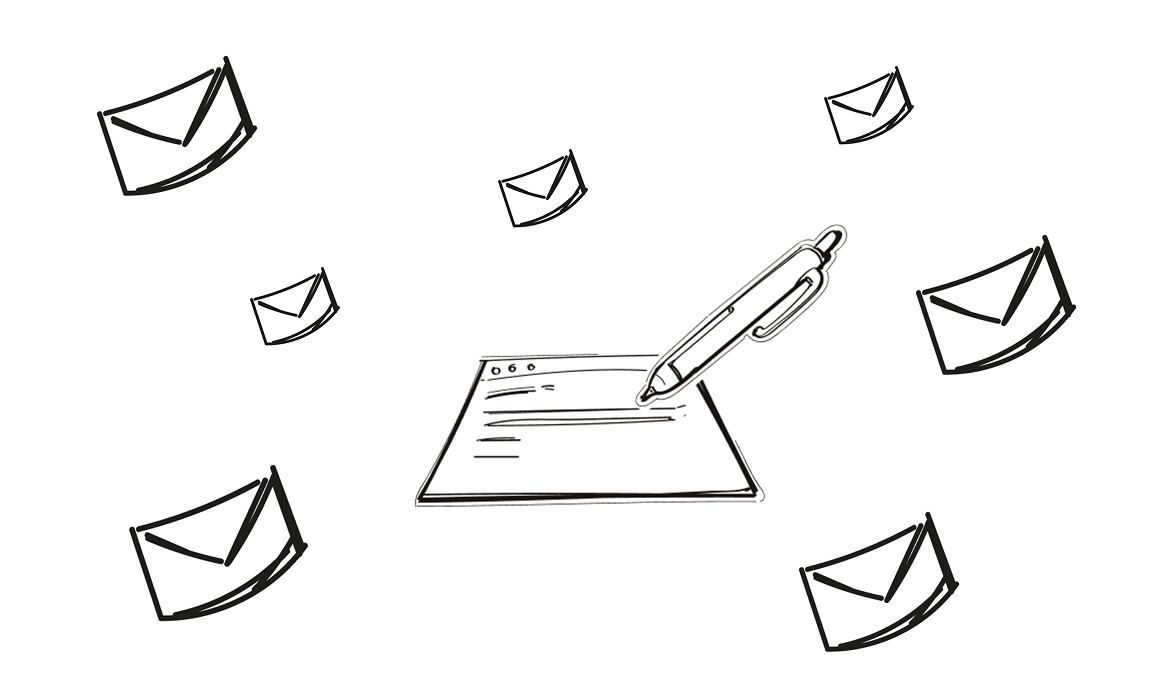Your call to action might be the missing link if your cold emails aren’t getting replies and conversions.
A good CTA turns interest into action, and a vague one stops momentum cold.
In this guide, we’ll show you how to write CTAs that actually get responses, plus share proven examples you can swipe and adapt.
What is a cold email call to action (CTA)?
A cold email call to action (CTA) is the specific next step you want the recipient to take after reading your email.
It’s typically one short sentence or phrase that directs the reader to do something, e.g., book a call or forward the message to the right person.
Why CTAs matter in cold emails?
Your call to action isn’t a “nice to have”; it’s the moment that turns words into action.
Here’s how:
1. Clear direction = more replies
People respond when they know what to do next. No guesswork. No friction.
A CTA like “Are you open to a quick call next week?” gives your reader a simple yes-or-no decision. Skip it, and you risk them closing your email with zero follow-up.
2. Action words = action taken
Words like “schedule,” “reply,” or “book” work better than soft fillers like “let me know your thoughts.”
Why? Because they feel like doing something. They trigger action.
3. Personal CTAs perform better
71% of customers expect personalized interactions. A CTA that ties directly to their context shows you did your homework.
“Would it make sense to share a demo tailored for [Company Name]?”
That’s way more powerful than a blanket request. And yes, the data backs it up. Personalized CTAs can boost response rates by over 2x.
4. Urgency moves the needle
A little FOMO never hurt. Consumers often admit that scarcity influences their likelihood of making a purchase
CTAs like: “We have 3 trial slots left this week, want one?” tap into urgency and scarcity, and that gets people moving. No pushiness. Just a gentle nudge that now is better than later. And this approach can work for many audiences, even from really advanced technical industries – for example: “Want a quick presentation about our new aerospace component electronics before we finalize your order?”
How to write a good call to action for a cold email: step-by-step guide
Some time ago, we asked our team at Woodpecker about the best cold emails they ever received. What stood out? Every one of them had a specific and natural call to action.
Here’s what we learned and how you can use it to improve your own cold email CTAs:
Be clear and specific
A vague CTA is the quickest way to lose someone. If your prospect doesn’t know what you want from them, they’ll probably skip it.
Instead, spell it out. What exactly do you want them to do? Check a calendar? Reply with a question? Read a resource?
✅ Example from Agata’s favorite cold email:
“Let me know if you’d like to look at our event schedule and sponsorship opportunities.”
This line works because it’s concrete. There’s no guesswork. Agata knew what she’d get if she responded – a look at a schedule and sponsorship details. Simple.
Your turn:
📌 Avoid: “Let me know what you think.”
📌 Try instead: “Would you be open to a 10-minute call next Tuesday to review the options?”
Personalize the message
People don’t respond to generic outreach. They respond to messages that feel like they were written just for them.
That applies to CTAs, too. Tailor your ask to their context. Refer to their role or something you learned about their company.
✅ Example from Yurii’s favorite email:
“Open to learning more?”
It’s short, yes, but it follows an entire email full of targeted insights about his podcast appearance and the IPO. It feels personal, not mass-produced.
Even the CTA tone, casual and light, matches Yurii’s style and seniority.
Your move:
🎯 Add context from the rest of the message to make your CTA make sense.
🎯 Reference something specific you mentioned earlier.
Create a sense of urgency
Urgency doesn’t mean pressure. It means giving your prospect a reason to act now, not “sometime next month.”
That could be a limited offer or a relevant moment in their company’s journey.
✅ Example from Agata:
Agata’s email hinted at ongoing sponsorship opportunities with SalesLoft, Gong, Salesforce, already involved, and 30K monthly leads on the line.
That’s subtle urgency. If big names are already in and results are flowing, it’s natural to want to check it out sooner.
Use lines like:
📌 “We’re offering this to 5 partners this quarter.”
📌 “I have availability this Thursday or Friday – does either work for a 10-minute chat?”
Focus on a single action
Don’t ask your prospect to do multiple things. That’s work. Pick one thing and make it the easiest possible step forward.
✅ In Yurii’s example, the sender didn’t pitch a meeting or a product tour. They simply asked:
“Open to learning more?”
It’s one action: reply if yes.
Compare that to:
– “Book a call here / check out our site / reply with your thoughts.”
That’s too much. People don’t have time for a checklist.
Choose one of the following:
- A reply
- A short call
- A review of a doc or resource
That’s it. Don’t stack.
🛠️ Need a tool that helps you set up cold outreach fast and keeps your CTAs out of the spam folder? Try Woodpecker for free. It’s got built-in warm-up with deliverability checks, and a setup that makes cold emailing easier from day one.

Examples of great cold email CTAs
Want more inspiration? Check out these fantastic cold email CTAs:
1. “Are you the right person to speak with about [insert pain point]?”
This CTA is low-pressure and opens the door to internal referrals.
Best for SDRs or founders targeting mid-sized companies where job roles may be fluid.
2. “Would it make sense to connect for 15 minutes next week? I’ve dropped my calendar link here [insert link].”
It’s casual, time-bound, and puts the scheduling power in their hands.
Best for SaaS reps booking intro calls with busy decision-makers.
3. “If this sounds interesting, I can send a quick personalized video walking you through it.”
The offer of a personalized video shows effort and adds intrigue.
Best for outbound campaigns targeting prospects with low reply rates.
4. “Mind if I send over a one-pager tailored to your [industry/challenge]?”
Asks for permission first (which builds trust) and offers something custom.
Best for agencies or service providers selling complex solutions.
5. “Just reply with a number: 1 = Not a fit, 2 = Interested, 3 = Loop in someone else.”
A multiple-choice CTA makes it incredibly easy to respond.
Best for high-volume cold email campaigns where you want quick qualification.
6. “Want to see how we’re helping others in [their industry] solve [business challenge]?”
Ties your offer directly to a relatable pain point and piques curiosity.
Best for B2B reps in competitive verticals (legal, finance, healthtech).
💡 Pro tip: Tools like Woodpecker help you personalize cold emails at scale so CTAs like these feel like they were written one-on-one, not blasted out.
7. “Should I loop in someone from my team for a deeper dive?”
Offers next steps without being pushy and keeps the ball moving.
Best for later-stage follow-ups or technical sales conversations.
8. “Would a quick interest-based call make sense this week or next?”
Frames the call around their interest, not your pitch.
Best for personalized cold email campaigns aimed at high-intent leads.
9. “Here’s a recent LinkedIn post from a client who tried this. Want to chat?” [insert link]
A social proof CTA that’s organic and human.
Best for founders or consultants who build trust through real conversations.
10. “Is [specific day/time] open for a short call to unpack this?”
A specific date CTA is more actionable than vague timeframes.
Best for sales teams trying to boost meeting acceptance rates.
11. “Open to a quick chat to see if we’re a fit or if I should stop bothering you?”
Self-aware, respectful, and written in a way that makes it likely to earn an honest reply.
Best for 2nd or 3rd follow-ups that need a gentle nudge.
12. “If not you, is there someone better suited to handle this?”
A polite “kindly refer” CTA that keeps your email from being a dead end.
Best for cold outreach when the right person isn’t obvious.
13. “Want to see how this could free up your team for more meetings?”
Leans into a strong benefit, time and results, with zero hard sell.
Best for: Cold email software or automation tools pitching to sales leaders.
14. “Would a short demo help clarify if this belongs in your sales pipeline?”
Positions the offer as an evaluation tool, not a commitment.
Best for solutions trying to get a foot in the door at the evaluation stage.
15. “Happy to send examples of how other teams have used this. Want to see?”
Friendly and open-ended, also clearly interest-based.
Best for first emails where the prospect might need more context before replying.
16. “Can I grab a few minutes to learn more about your [business goal] this quarter?”
It’s framed around them and positions you as curious and helpful.
Best for early-stage outreach focused on relationship-building, not pitching.
Check this out: Cold Email Course
17. “Just hit reply with ‘curious’ and I’ll send a quick explainer + link.”
Ultra low-effort and curiosity-driven. Great for inbox skimmers.
Best for cold email campaigns targeting busy execs or founders.
18. “Would it be useful to walk through a few action examples from teams like yours?”
Proposes specific value while keeping the tone helpful, not pushy.
Best for B2B sales where most prospects want to see proof before committing.
19. “Open to a quick meeting this week to see if we’re aligned on [insert goal]?”
Specific and goal-oriented. The hallmarks of a persuasive call.
Best for follow-ups after some engagement (e.g. click, open, or visit to landing page).
20. “Who’s the best person on your team to speak with about this?”
A classic best cold email CTA that keeps the conversation going, even if you hit the wrong inbox.
Best for selling into layered orgs or when job titles don’t tell the full story.
21. “Want me to send a free study on how others in [industry] improved conversion rates?”
Combines social proof with relevant insight.
Best for marketing or CRO tools offering value-first touchpoints.
22. “Mind if I share a landing page with examples from teams solving [insert pain point]?”
Subtly invites the prospect to self-qualify, no hard ask.
Best for SaaS tools with case studies or customer stories baked into their pages.
23. “Is this currently a top priority, or should I check back later in the quarter?”
An open-ended question that respects timing and filters real interest.
Best for strategic solutions where timing plays a major role.
24. “Would a short deck help explain the value proposition better than this email?”
Offers clarity and gives them a reason to say yes without scheduling anything.
Best for cold email software or platforms with visual payoffs.
25. “Want to see how we helped [similar company] generate new leads in 30 days?”
Concrete result + short time frame = effective CTA.
Best for agencies and tools focused on lead generation or sales acceleration.
26. “How are you currently handling [pain point]? Happy to share some shortcuts.”
Acts as a conversation starter and shows you’re not here to monologue.
Best for personal outreach or follow-up messages that invite dialogue.
27. “If you’re open to chatting, I’ll send over a few times, or feel free to book directly here [calendar link].”
Smooth scheduling CTA with options for either personality type.
Best for mid-funnel prospects or those who’ve clicked your email but gone quiet.
28. “Want to hear the subject line that got a 63% open rate last month?”
Relevant and curiosity-spiking, also practical.
Best for copywriters or anyone selling conversion rates.
29. “Would you be open to reviewing a few CTA examples we tested with your target audience?”
Targets marketers or sales managers who value experimentation and proof.
Best for campaign consultants or copy coaches.
30. “If nothing else, I’d appreciate a quick no, just so I don’t keep popping in uninvited.”
Lightly self-deprecating and respectful, gets replies from even cold leads.
Best for last-touch follow-ups in a successful cold email campaign that values honest replies over vanity metrics.
Check out: Perfect CTA – how to write a persuasive cold email?
What to remember when writing your next CTA
✅ Keep it human – no corporate phrases or robotic copy.
✅ Be respectful of their time – a soft ask gets more replies than a hard push.
✅ Tie it to your email body – CTAs work better when they follow naturally from the context.
Conclusion
The best cold email CTAs feel easy to say yes to.
Use the tips and examples above to fine-tune your next email and make that reply more likely.
And if you want your next CTA to land in the inbox (not the spam folder), start a free trial with Woodpecker.
It covers everything, from lead finding and warm-up to email verification and inbox rotation, so you can focus on writing great messages that get replies.

